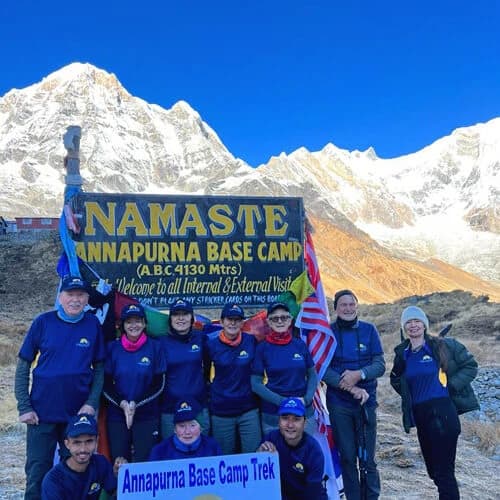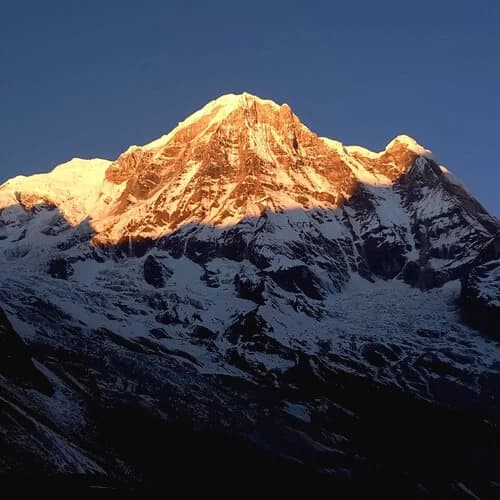Annapurna Base Camp Trek is a famous expedition in Nepal, alongside Everest Base Camp Trek and Annapurna Circuit Trek. This exciting adventure combines unique hiking experiences, enchanting cultural immersion, and breathtaking natural beauty. The ABC Trek's difficulty level is moderate compared to other high-altitude treks in Nepal. Individuals with a reasonable fitness level can complete the expedition easily and comfortably. The trek takes you through distinctive terrain and landscape, which can be challenging if you are unprepared. Our destination for the trek is the spectacular Annapurna Base Camp, which is surrounded by Annapurna Massif, Machapuchare, and Hiunchuli surround it. Along the route, you can enjoy the panoramic views of these glorious mountain peaks and immerse yourself in the local culture by interacting with the friendly locals and experiencing their unique traditions. As you step onto the trail, an exciting adventure awaits you as you discover hidden landscapes, serene natural beauty, and cultural immersion.
Annapurna Base Camp Trek Difficulty
Is the Annapurna Base Camp Trek difficult?
While the ABC Trek's terrain and trails are less demanding than some other high-altitude treks, they require proper preparation and training. The trek's moderate nature means that you can conquer it with a proper mindset and reasonable fitness. Our staff members' expertise will also be a constant source of guidance and support, ensuring your safety and well-being throughout the journey. Their knowledge of the terrain and trekking experience will help you navigate the trail confidently.
What Factors Make the Annapurna Base Camp Trek Difficult?
The Annapurna Base Camp Trek is a moderately challenging trail, but it only features adversities that can be overcome by seasoned or novice trekkers. Like many other expeditions, this trek also features factors that contribute to its overall difficulty. These include elements like durations, distances, altitudes, accommodation, terrain, etc.
Trek Altitude
The ABC Trek reaches an altitude of around 4,130 meters (13,550 feet). So proper preparation and training are required to overcome the steep ascent during the trek. The elevation gain can also lead to Acute Mountain Sickness (AMS). However, you can mitigate this risk with proper acclimatization and rest. Moreover, ascending slowly and taking regular rest days allows your body to adjust to thin air, reducing the chances of altitude-related issues. We highly recommend staying hydrated and maintaining a nutritious diet plan. Besides, avoiding alcohol and smoking is also crucial, ensuring your safety and well-being on the trek.
Trek Duration
The duration of the trek varies depending on your specific route. A longer trek includes adequate time for acclimatization and rest days, which are essential for adjusting to the altitude and reducing physical strain. This also allows for a slower ascent, which can help prevent altitude sickness and provide a more enjoyable trekking experience. Choosing a duration that aligns with your health conditions and physical fitness is essential. A well-paced trek ensures you can fully appreciate the stunning landscapes without feeling tired.
Trek Distance
The total distance of the ABC Trek is approximately 110 kilometers (68 miles). On average, trekkers walk about 6-8 hours daily. The distance can vary based on fitness levels, weather conditions, and trail difficulty. Trekking guides often adjust the hiking time to match the physical capabilities of the group, ensuring a manageable and enjoyable pace. If you are still getting familiar with long-distance trekking, you may find the trek tiring and uncomfortable. So. following a regular physical fitness routine, including cardio exercises like walking, running, or cycling, is advisable to build stamina for the trek.
Trek Route and Terrain
The Annapurna Base Camp Trek route features diverse terrain, including stone steps, rocky paths, and uneven surfaces—the trail's landscape changes frequently, which demands adaptability and physical agility during steep ascents and descents. Certain sections of the trail are narrow and twisting with cliff edges, which can be challenging for trekkers. This varied terrain requires mental preparedness and physical endurance to navigate safely. It is essential to wear appropriate trekking gear, including sturdy boots with good ankle support, to manage the uneven ground and ensure a safe trek.
Weather
Weather conditions on the trek vary significantly depending on the season. The best times to trek are during the pre-monsoon (March to May) and post-monsoon (September to November) seasons, when the weather is stable and visibility is clear. During these periods, daytime temperatures range from 10°C to 20°C (50°F to 68°F), while nighttime temperatures can drop to below freezing at higher altitudes. Monsoon season (June to August) brings heavy rainfall, making trails slippery and dangerous, while winter (December to February) can be freezing, with heavy snowfall blocking paths and making trekking more challenging. It is essential to check weather forecasts before your trek. Moreover, it would help if you were prepared for sudden weather changes by carrying appropriate clothing and gear, such as rain jackets, warm layers, and sun protection.
Accommodations
During the trip, you will stay in teahouses and lodges. These basic but comfortable accommodations offer cozy beds and hearty meals. Staying in teahouses is also a great way to meet fellow trekkers and share your experiences. However, the decrease in facilities and amenities as you ascend higher during the trek can be a challenging experience. We recommend you pack basic necessities such as toiletries so you won't face such problems during your stay.
How to Prepare Yourself for the ABC Trek?
Physical Fitness
Being physically fit is crucial for trekking in the Himalayas. The Annapurna Base Camp Trek is challenging, but cardio and strength training exercises will help you prepare for the journey ahead. Include cardiovascular exercises like running, cycling, or stair climbing to boost your endurance. Strength training is also essential, so focus on exercises for your leg muscles, core, and upper body. This will help you navigate uneven and steep trails. Regular exercise routines, like brisk walking or jogging, can significantly enhance your stamina.
Mental Preparedness
A positive attitude and determination are essential for your trekking journey. Trekking is as much a mental challenge as it is a physical one. Learn about the trek, including the route, challenges, and weather. Being well-informed helps you prepare mentally for the difficulties you might face. Trekking at high altitudes can bring unexpected problems. Thus, mental resilience enables you to face these obstacles calmly. Moreover, mindfulness and visualization techniques can help you stay focused and motivated during the trek.
Acclimatization
Acclimatization is essential to avoid altitude sickness during the trek. The air gets thinner at high altitudes, and your body needs time to adjust to the reduced oxygen levels. Therefore, rest days are required to allow your body to adapt. We advise staying hydrated, maintaining a balanced diet, and avoiding alcoholic beverages. If you experience nausea, dizziness, and headaches, take them seriously and inform the trek guide. Don't force yourself on the trek; descend to a lower altitude if necessary. Strolling and taking regular breaks can also help your body adjust better to the altitude.
Safety and Health
Before starting your trek, get a thorough medical check-up to ensure good health. If you have any pre-existing conditions, inform your trekking company so they can make the necessary arrangements. We also recommend you pack a basic first aid kit with medications for common illnesses like headaches, colds, and stomach issues. Blister treatment supplies, bandages, and personal medication are also wise.
Travel Insurance
It would be best to have comprehensive travel insurance covering high-altitude trekking and emergency helicopter evacuations. In addition, you must trek with a reputable company that provides experienced guides and proper equipment. Travel insurance should also cover medical expenses, trip cancellations, and lost or stolen belongings. We advise you to verify that your insurance policy includes coverage for trekking up to 4,500 meters, which covers the Annapurna Base Camp altitude.
Health and Medications
Maintaining your health is crucial for a successful trek expedition. Carry essential medications, including those for headaches, diarrhea, and colds. It's advisable to have a small supply of antibiotics and altitude sickness tablets, such as Diamox. Make sure you have any prescription medications you regularly take and carry a copy of the prescription with you. Rehydration salts and pain relievers should also be used to manage minor health issues. It's also helpful to have motion sickness pills if you are prone to nausea, especially during the bus ride to and from the trekking start point.
Dietary Preferences
Maintaining a nutritious diet while trekking is crucial for your energy and stamina. The tea houses along the route typically offer simple meals like rice, lentils (dal bhat), noodles, and vegetables. These meals are high in carbohydrates and provide the energy needed for trekking. If you have specific dietary preferences or restrictions, you must inform your trekking company so they can make the necessary arrangements. It's also wise to carry high-energy snacks like nuts, dried fruits, and energy bars.
Practical Tips for making your trek easier
- To make your trek more enjoyable, here are some practical tips:
- Pack Wisely: Good-quality trekking boots, sleeping bags, and warm clothes are best to tackle changing temperatures and uneven terrain. Remember essentials like a first aid kit, water purification tablets, and high-energy snacks.
- Hire a Guide and Porter: The services of a guide and a porter can enrich your experience with local knowledge. Porter can help carry your heavy backpack, making the trek less challenging.
- Stay Hydrated and Eat Well: Eat nutritious meals and hydrate yourself to keep your energy levels up. The local dish, dal bhat (rice and lentils), is an excellent source of protein, nutrients, and carbohydrates.
- Respect the environment: Carry your trash with you, and respect local wildlife and vegetation.
Some Most Popular Treks
- Everest Base Camp Trek - 14 Days
- 12 Days Everest Base Camp Trek
- Everest Base Camp Luxury - 14 Days
- Everest Cho La Pass - 17 Days
- Everest High Pass 16 - Days
- Annapurna Base Camp - 13 Days
- Ghorepani Poon Hill - 7 Days
- Annapurna Circuit - 17 Days
- 12 Days Annapurna Circuit Trek
- Manaslu Circuit - 14 Days
- Manaslu Trek 12 Days
- Everest Base Camp with Island Peak - 16 Days
- Everest Luxury Trek with Helicopter Return
- Langtang Valley - 10 Days




